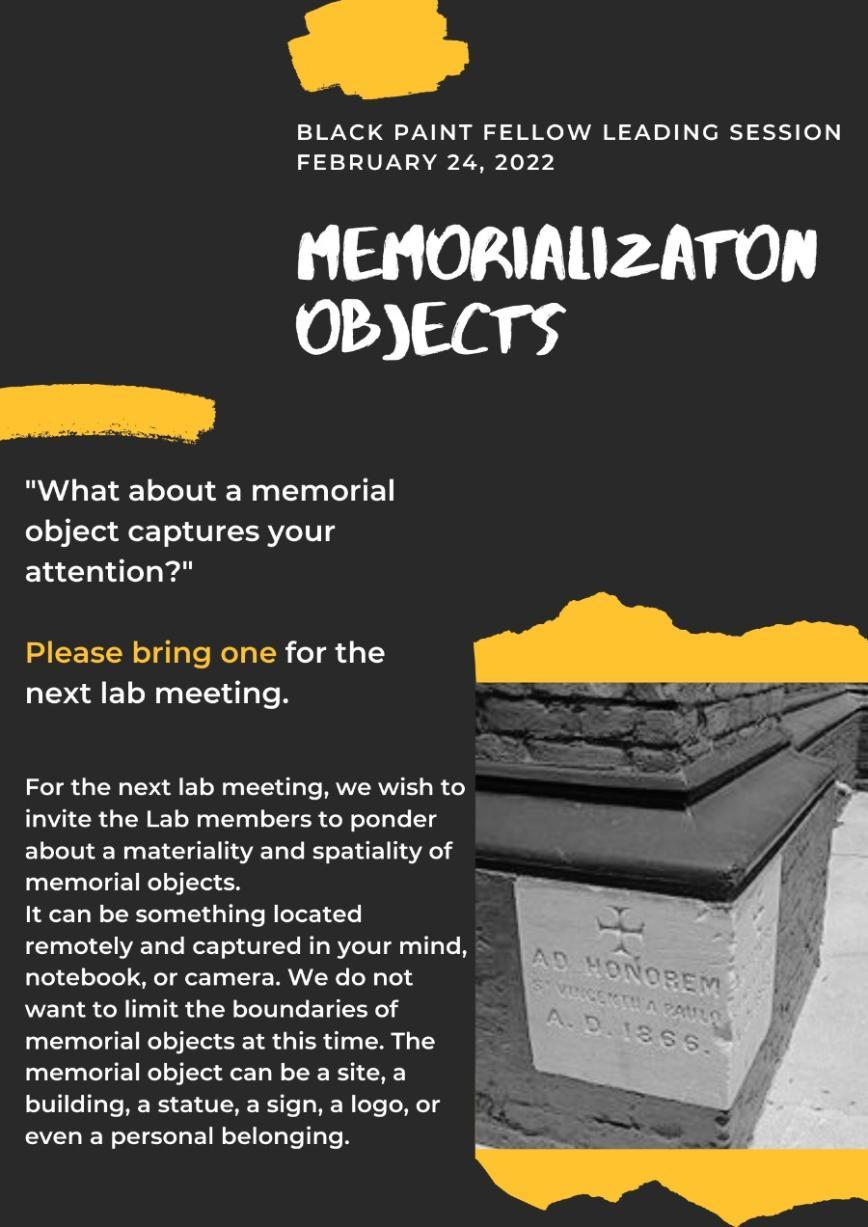We invited the members of Lab to ponder the materiality and spatiality (Schmidt, 2015) of memorial objects for the Lab session we lead on February 24. Lab members were asked to identify a memorial object in their space and bring it to the session. We suggested the concept of memorial objects as something located remotely or captured in an individual’s mind, notebook, or camera. We did not want to limit the boundaries of memorial objects because we wished to invite the lab members to an expanded possibility of observing spatiality around them through an object. In addition, we suggested a prompt might be helpful to the lab members.
- What about a memorial object captures your attention?
Here are our reflections from the lab discussion.
Benjamin
Listening to our first sharer in the session I was not sure what to expect and when Yvonne took the initiative to share her screen (following up my own screen sharing facilitated by Jonggeun) the photograph she shared was immediately beyond what I had imagined a memorial to be. As she explained her father’s story and I was able to look at the photograph more closely of the men posing with a basketball in hand and uniforms on and I realized this was precisely what I had invited into the lab space and was eager to let participants join breakout rooms.
In retrospect, the small groups seemed incredibly linked to Yvonne’s initial sharing and our group spoke about personal memorial objects in relation to deceased relatives we feel a particular connection to.
I really appreciated the way this prompt allowed participants to explore their own memory and share those memories and histories with the class. In my own classroom I am teaching undergraduates at Columbia there are a mixture of students from different nationalities and social backgrounds. In this context, I wonder how the makeup of the class might inform different dynamics of sharing. For instance, what knowledge is brought into the classroom and how to adjust for discrepancies or uneven-ess of certain kinds of emotional and cultural knowledge that are unique to each student. In future exercises like these there should be conversations with participants about how sharing different perspectives, histories, and experiences.
People’s openness and willingness to share their thoughts in the big group discussions was also a nice way to draw together some of the threads that wove the workshop together. I have interest in focusing a curricular endeavor on material objects and the built environment given the reality of the different stories and relationships various students bring to the same objects and places.
Jonggeun
In the very beginning phase of the session preparation, we began with the discussion about history, spatiality, materiality, memory, and affection. We did not have a particular subject that we wanted to bring to a Black Paint session. At some point, fortunately, we arrived at an agreement to use “material objects” for our fellow leading session because it seemed in the conjunction of our mutual interests. Our initial idea was more closely related to public objects rather than personal objects as the term “memorial object” invokes the sense of public materials. For the diversity of discussion, however, we made a plan that included a personal memorial, yet it was not the main part of the plan.
As a result of workshopping our plan with Sarah and Jackie, which was a very useful learning experience for us, we tried to focus more on an essential prompt rather than providing several questions to participants (Wiggins, G., & McTighe, J., 2005). We also changed some time plans for effective discussion. It helped us to concentrate more on the session’s focused topic (Sleeter, 2005): your relationship with a memorial object. Sandra’s previous Black Paint session about spatiality was also helpful for us to figure out the concept of spatiality and a space’s social relationship to individuals (Soja, 1996). Every session preparation process was a great opportunity to experience communication and collaboration for building a curriculum.
More than half of the members brought very personal memorial objects, which was different from my initial expectations. I anticipated that we would hear members’ personal relationships to a rather public memorial such as memorial site, statue, signs, etc. I, however, soon realized that the memorial objects that members brought were very personal, which is inevitably related to a big picture of history. A member brought her grandmother’s photo which was she thought she lost. We could hear how her grandmother lived and raised her kids throughout the dynamic history of her country. Another member brought jewelry passed down from generation to generation, strongly connected to her family’s authentic culture. I introduce a photo of a public statue directly connected to my country’s colonized history, but I could not deny that public statute gives me very personal emotions. Indeed, every personal memorial object is historical, and we cannot talk about a public memorial object without people’s personal relationship to that.
It was a learning experience of a curriculum building.

References
Schmidt, S. J. (2015). A queer arrangement of school: Using spatiality to understand inequity. Journal of Curriculum Studies, 47(2), 253-273.
Soja, E. W. (1996). Thirdspace (1st edition). Wiley-Blackwell.
Sleeter, C. (2005). Chapter 3: Designing curriculum around big ideas. In Un-standardizing curriculum: Multicultural teaching in the standards-based classroom (pp. 43-63). New York: TC Press.
Wiggins, G., & McTighe, J. (2005). Understanding by design (Expanded 2nd ed.). NJ: Prentice Hall.